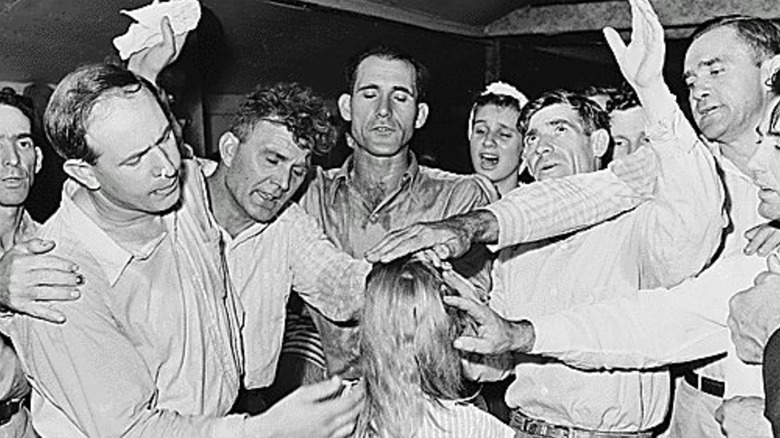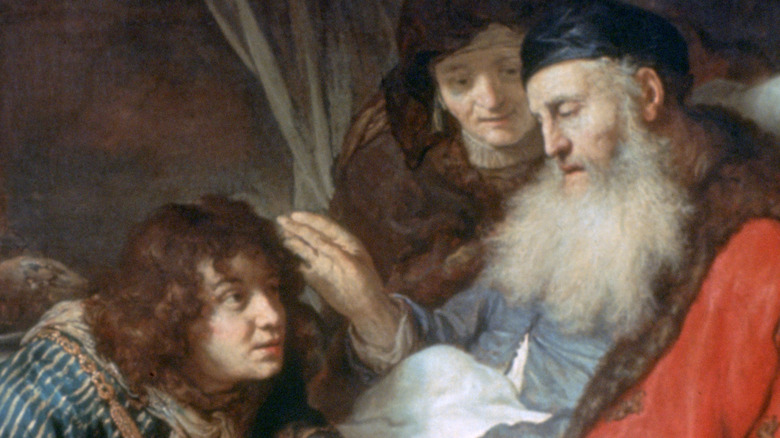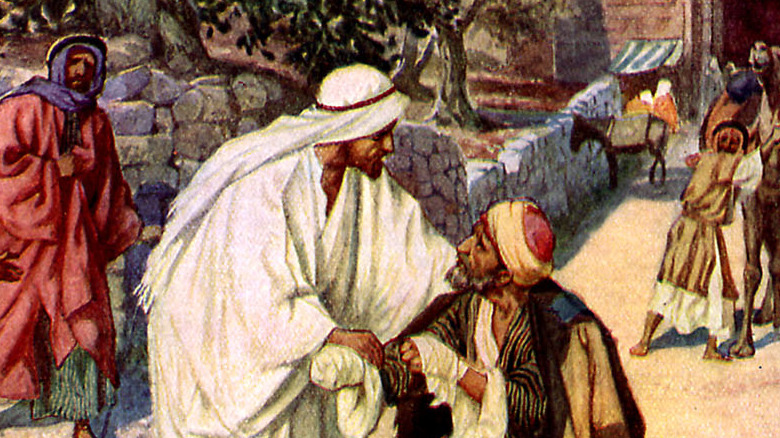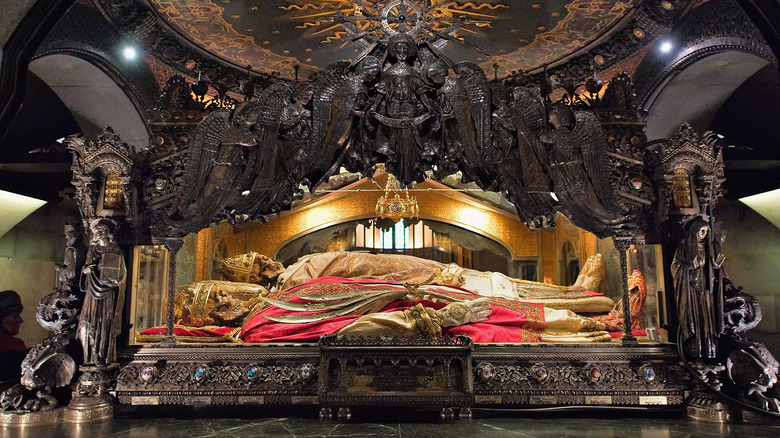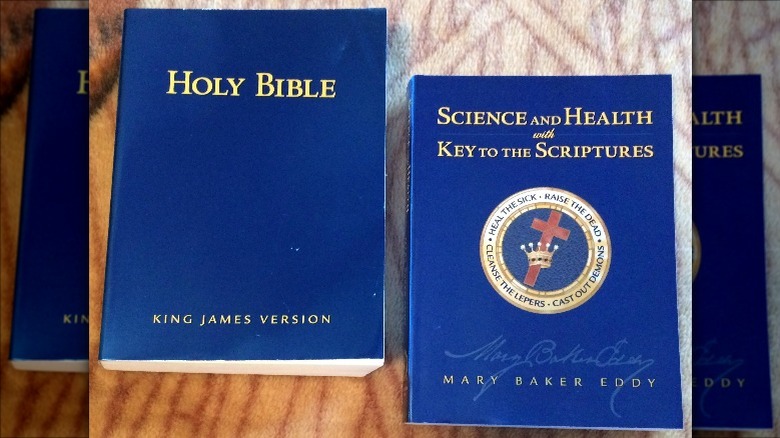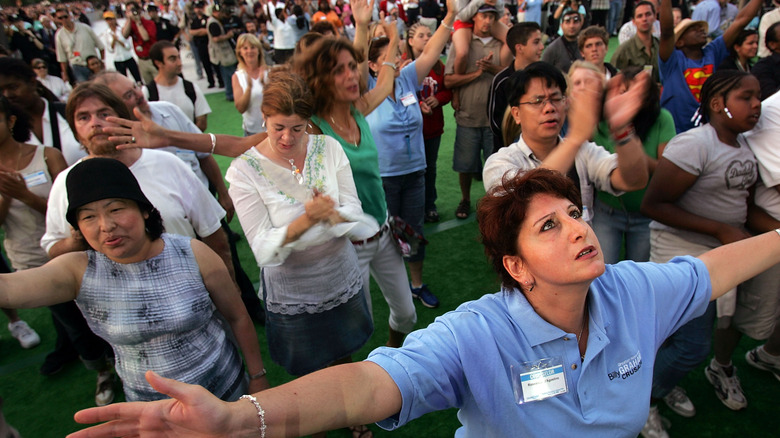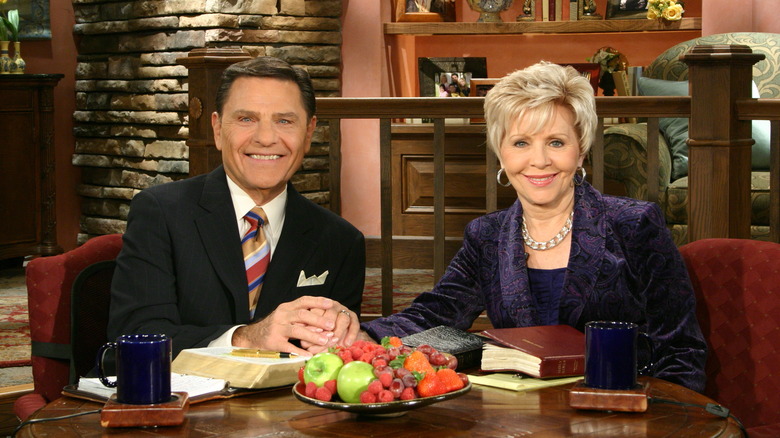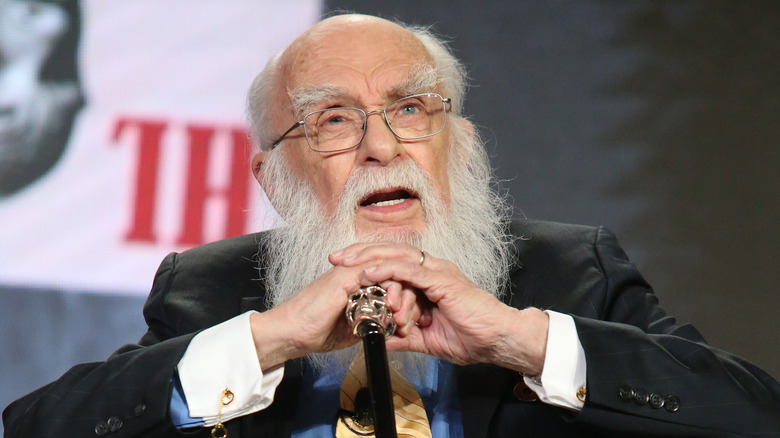The Controversial History Of Faith Healing
Faith healing is defined as "a method of treating diseases by prayer and exercise of faith in God." While people of any faith might pray for good health, faith healing is typically associated with forms of Christianity.
Many scientific studies have been done attempting to determine if faith healing really cures disease. "Prayer and healing: A medical and scientific perspective on randomized controlled trials" looked at some studies that considered the possibility that divine intervention can heal the sick. One theory discussed is that prayer is a form of meditation – and meditation has proven medical benefits, such as lowering heart rate and boosting immune response. Another possibility is that those relying on faith healing experience the placebo effect, which has been shown to benefit patients with all types of conditions. Spontaneous remission (sudden improvement from a medical condition) or regression to the mean (improvement in a condition that is due to random fluctuation) may occur after faith healing, causing the patient to believe that prayer caused the improvement.
Anything that improves patient morale is generally considered positive, but for some, faith healing is anything but harmless. Famously, scammers claiming the ability to heal the sick have bankrupted ill believers for their own gain. Some sects that believe in faith healing have also condemned the use of medication and treatments by physicians, and believers – and their children – suffer deadly consequences from treatable diseases. Let's take a look into the controversial history of faith healing.
Old Testament origins
The Old Testament understanding of disease was that it was a direct consequence of the actions of the sick person. It was believed that a person's health would improve if they obeyed the Lord's wishes.
As explained in "Illness and God's Will," disease was a "curse" performed and placed on human beings by God. The Lord would use sickness to "destroy" people who did not serve Him. Getting well again would be seen as having begun to live a holy life and being forgiven by God. "A Brief History of Faith Healing" details how prophets and priests would make sacrifices on behalf of the sick and suggest treatments. Asking for medical treatment from somewhere other than the Lord was thought to be at best useless and at worst a sin.
Some early Jews thought that looking for treatment from anywhere other than the Lord was proof that they "do not trust God the Savior completely." Others viewed methods, such as, "doctors, herbs, medical compounds, and rigid diet" as also coming from God. While faith healing is often associated with Christians, some modern Jews also believe in Faith Healing. Rabbi Naftali Brawer for The JC states that "rabbis tend to permit at least certain incantations as medically effective and halachically permitted ... Prayer is a form of faith healing which is widespread in Jewish practice."
New Testament healing
The New Testament portrays Christ as "a great physician." In the Gospels, Jesus healed blindness, deafness, and disability. While this direct healing by Christ is different from the curing of disease depicted in the Old Testament, there was still a strong moral component. As stated in "A Brief History of Faith Healing," "Physical healing was secondary to His spiritual ministry ... Without his God-ward incentive, healing had no value."
Jesus' method of healing did not involve any treatments, instead he is depicted as casting out demons. Christ also gives the Apostles "power against unclean spirits to cast them out and heal all manner of diseases and all manner of sickness."
Jesus being depicted as giving his followers the ability to fight disease with religion creates a precedent for Christians to turn to faith healing to treat their medical conditions. When early Christians got sick, they would call for elders, confess their sins, and be absolved. Others would purchase Christian talismans that they believed would heal them.
Shrines and talismans in the Middle Ages
Many medieval priests denounced some treatments as magical and sacrilegious while endorsing exorcisms and amulets as holy. A pastoral manual from approximately 1210, quoted in "Medical Magic and the Church in Thirteenth-Century England," advises, "Faithful priests should impress on their people so that they know that magic arts and incantations cannot bring about any remedy for any human illnesses, nor can they heal in any way animals which are weakening or lame or even dying; but rather these things are snares and traps of the ancient enemy, with which he perfidiously labors to entice the human race."
Despite the condemnation of "superstitious" treatments, in the fourth century a fascination with martyred saints led to a cultural obsession with relics in Europe. These could be anything from shards of wood believed to be from the original cross to bones said to be taken from the dead saint's graves. As stated by Britannica, many believed that if a sick woman lay on the cross her illness would be cured. By the Middle Ages, both saints and their relics were believed to be able to perform miracles.
Modern faith healing: Catholicism
The modern Catholic Church tends to promote the idea of slowly improving the lives of believers by restoring family relationships or fostering a stronger faith in God, rather than instant miracles that cure physical illnesses or conditions. According to the New York Times, Catholics caring for the terminally ill are more likely to advise that the family "pray for serenity and acceptance" instead of hoping that God would cure their loved one. Despite this, there are still many Catholics who make pilgrimages to holy sites with the hope of being cured.
One popular pilgrimage site is Our Lady of Lourdes in France, which has long been believed to have the power to heal. According to the Telegraph, about six million people visit Lourdes every year (pictured). Rev. James Ewens, a Jesuit priest who directs an interfaith hospice for the dying, told the New York Times, ”Obviously, Lourdes is a very special center, but we need to put it in the broader context of physical, emotional, and spiritual health. A psychological or spiritual healing can be more significant than a physical one.”
The Catholic Church has not entirely moved away from the idea of miraculous healing, however. As explained by the Associated Press, to begin the process of canonizing a new saint (who wasn't a martyr) their supporters must prove that they performed a miracle. In order for the Catholic Church to consider the miracle legitimate, the cure must have happened instantly, be complete, and permanent.
Modern faith healing: LDS
The Church of Jesus Christ of Latter-Day Saints has a concept called priesthood, described as "The power and authority that God gives to man to act in all things necessary for the salvation of God's children." The priesthood is also stated to be the same power that Christ used to perform his miracles – including healing the sick. "When I lay hands on the sick, I expect the healing power and influence of God to pass through me to the patient, and the disease to give way," Brigham Young is quoted as telling his followers.
While the LDS Church endorses scientific medical treatment, they also encourage members to pray for loved ones who are sick to be healed, and credit the power of prayer with causing some spontaneous recoveries.
The modern LDS Church does not discourage its members from seeking professional medical care. In fact, Brigham Young described asking Elders to "lay hands" before seeking other treatments as the equivalent of asking God to make crops grow without planting any seeds.
Modern faith healing: Christian Scientist
Possibly the most famous example of faith healing in the modern world comes from Christian Science. As noted by Britannica, curing disease through prayer is not only possible, but mandatory for its believers who are seeking redemption.
The Church of Christ, Scientist dates back to the late 1800s and follows the teachings of founder Mary Baker Eddy. In 1886, Eddy had recovered from a fall after reading about Christ's ability to heal in the New Testament. She came to believe that the physical, observable world was not real, and therefore illness was not real. She preached that believers had the ability to alter their reality with beliefs. "When sick (according to belief) you rush after drugs, search out the material so-called laws of health, and depend upon them to heal you, though you have already brought yourself into this slough of disease through just this belief," Eddy wrote (via the ABC.)
While professional medical treatments are not officially forbidden to modern Christian Scientists, many feel pressure to avoid turning to anyone but God to cure their illnesses. As noted by The Guardian, believers campaigned for religious exemptions from vaccinations, tests, and standard procedures. Because of this, there have been outbreaks of preventable diseases like polio and measles in Christian Science communities. Some members choose to refuse treatment no matter how sick they are, leading to deaths from curable illnesses.
Modern faith healing: Evangelical
As noted by "The American evangelical faith healing movement and the emergence of Pentecostalism," in the 19th century, evangelical faith healing became increasingly popular, attracting many seeking cures for medical conditions. According to NPR more than 30% of modern Americans consider themselves some kind of evangelical or born again Christians, though it is difficult to determine exactly what qualifies as an Evangelical faith. As noted by The Washington Post, Pentecostal and Charismatic Christians believe that any Christian can be a healer. They believe that they can do everything from speaking in tongues to resurrecting the dead.
Charismatics gained public attention in 2020, during the Covid-19 Pandemic, because of their belief that they can heal the sick with faith healing. Some Charismatics believe they can cure anything from cancer to the coronavirus. While faith healing typically involves "laying on of hands" or placing hands on the head of the sick person to provide a blessing, during the pandemic, some offered faith healing over the phone.
What faith healers claim to cure
Faith healers have claimed to be able to cure all kinds of diseases. As noted by Ohio State University's "The Psychology of Extraordinary Beliefs," faith healers have not only claimed to be able to cure diseases like AIDS and cancer, but also to reverse conditions like blindness or deafness. Some, like those described in The Washington Post, even claim that they are able to resurrect the dead.
Mild illnesses that improve naturally without treatment may coincide with a visit from a faith healer, making the patient believe that they were healed by God rather than their own immune system. It is also believed that the "placebo effect" or a morale boost from the belief that one will get better, can improve immune function. This may be enough to speed up the recovery of a minor illness. Those with severe conditions only get worse without medical treatment.
This was the case for 20-year-old Mariah Walton, who was born with a small heart defect. As detailed by The Guardian, her family were part of a fundamentalist Mormon group that did not go to doctors or seek professional care, relying exclusively on faith healing. Her family spent years praying for her recovery, but without medical treatment, her condition advanced until it became irreversible. In 2016, Walton had pulmonary hypertension, screws in her bones, relied on an oxygen tank to survive, and was considering multiple organ transplants to improve her chances.
Televangelists
"The Psychology of Extraordinary Beliefs" points out that unlike most varieties of pseudoscience that claim to cure disease, faith healing is often provided for free. That doesn't mean that there aren't scammers claiming divine power so that they can squeeze money out of sick people and their families.
One of the most famous of these was televangelist Peter Popoff, who famously claimed he could help his viewers to be healthy and debt free. As explained by Business Insider, in 1986, skeptic and magician James Randi played secret audio recordings that exposed Popoff's strategy for tricking believers on "The Tonight Show Starring Johnny Carson." Audiences believed that Popoff was able to know what conditions they were suffering from just by looking at them. But in reality, before each show, his wife and the rest of his staff went through the audience asking about their health. When Popoff finally came onstage, he had a tiny earpiece. His wife would tell him all the information they had gathered, so that he would appear to have miraculous knowledge.
The faith healer would go on to be debunked numerous more times, but it wouldn't stop him from scamming millions every year from his devoted followers.
Popular American faith healers
Peter Popoff was not the only televangelist who got rich by claiming to be able to heal the sick.
One of these was the evangelist Pastor Ernest Angley. As stated by Deadline, Angley brought in millions from his megachurch, which has been referred to as a cult. In 1984, his claims got him arrested for fraud and practicing medicine without a license. In 1985, he bought his own TV station to broadcast to his believers. In 2006, he got in trouble again, this time for claiming he could cure AIDS. He died in 2021, amidst floods of accusations of child labor law violations and sexual misconduct.
Televangelist and faith healer Kenneth Copeland (pictured) also took advantage of a public health crisis. According to Newsweek, in 2020, he claimed to have healed his viewers of Covid-19 through the TV screen. He encouraged them to touch their television screens while he did the same, claiming that his prayer to Christ had left them, "healed and well." This is not the first time Copeland has been accused of scamming his followers. While his exact income is unknown, USA Today reported that Copeland purchased three private jets and his own airport.
Investigations by skeptics
Many have assumed that faith healing is something the patient and healer both want to try because of their devout faith in the healing power of God. In the late '80s, however, James Randi investigated the methods of popular American faith healers, and came to believe that they were deliberately defrauding the sick.
As detailed in an article published in the Journal of Religion and Health, Randi became invested in revealing the truth about faith healers after witnessing "Philippine psychic surgeons" using simple sleight of hand to scam the sick. As he investigated American faith healers, he found that they used the same methods of deception. Randi described this as "doing a magic act disguised as religious miracles."
Along with Peter Popoff's earpiece, Randi discovered many examples of intentional deception on the part of popular faith healers. Some were as simple as having an assistant provide information secretly with hand signals, while others as insidious as offering wheelchairs to any audience members that were able to walk with a cane before the show began, so the healer could appear to cure their condition by simply having them stand up from their chair.
Faith healing can be a crime
Attempting to cure people through prayer alone is not, by itself, a crime. However, when going to medical doctors and accepting treatments are forbidden, it may be illegal – particularly if there are children involved. While some, like Ernest Angley, have gotten into legal trouble over their false claims alone, most criminal cases around faith healers are about child abuse and neglect.
"The right to practice religion freely does not include liberty to expose the community or the child to communicable disease or the latter to ill health or death," Supreme Court Justice Rutledge (quoted by Criminal Liability in Faith Healing) wrote, "Parents may be free to become martyrs themselves. But it does not follow they are free, in identical circumstances, to make martyrs of their children before they have reached the age of full and legal discretion when they can make that choice for themselves."
In 1998, a church with its origins in Pentecostalism sparked outrage when it was discovered that over 75 children in the congregation had died since 1995, more than 20 confirmed to be from curable diseases. As noted by the AP, this led the state of Oregon officially remove religious beliefs as a defense against murder and manslaughter. In 2017, a couple in the church had a child die shortly after birth. The couple did not call an ambulance or seek medical help. They eventually pleaded guilty to negligent homicide and criminal mistreatment.
